Bizarre Natural Phenomena Vol.10 – Fishing By The Dragon’s Breath (The Lava Lake Of Mount Erebus)
Most people when they hear the word lake, they think of a peaceful place, where they can go swimming, fishing and relax by having a barbeque near its banks. But there are a few lakes that would turn you into a barbeque if you dared to get closer. One of them is the Lava Lake of Mount Erebus in Antarctica (we met this guy in the Ice Fumaroles episode). Erebus comes from the greek word έρεβος (e-re-vos) that means darkness and this is quite true, for dark are the secrets this mountain holds within its core.
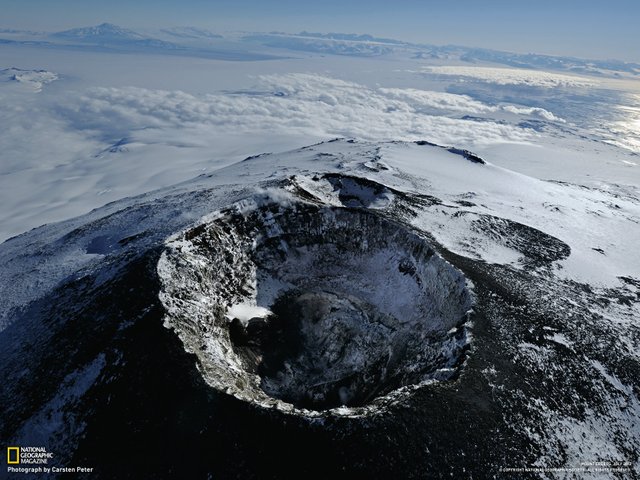
(Image from: nationalgeographic.com)
What is a lava lake?
Pretty much as its name declares, a lake full of lava, molten rock in scorching temperatures, dangerous and destructive. Lava lakes form in the crater of a volcano. They can also fill volcanic vents or depressions in the ground and turn them into lakes. They are very rare, because they don’t get to survive long on the earth’s surface. The lakes usually disappear either by returning to the magma chamber (after pressure is relieved) or drain through eruption of lava flows or pyroclastic explosion. By studying them, geologists will gain a better understanding on how they function. Right now we can see only 6 on the planet (you’ll find a list at the end of the article).
Why Mount Erebus?
Mount Erebus is really special. It’s the world’s southern most active volcano and that’s not just it. Its lava is similar to two other volcanoes on earth (Erta’Ale in Ethiopia and Nyiragongo in the Congo), whereas its crystals are similar to a few other volcanoes. Adding to that, its lava composition very much resembles the one of Mount Vesuvius (a well-known killer of the past) and it’s a rare, phonolitic-type lava (phonolite is more viscous than the usual basaltic magmas we come across most volcanoes).
If you’re not convinced yet, I got more facts for my rationale. Mount Erebus is one of the very few volcanoes that remain consistently active, by gas and volcanic bomb release. This behavior has been showing a specific, yet awkward, consistency. Let’s take a better look at it…
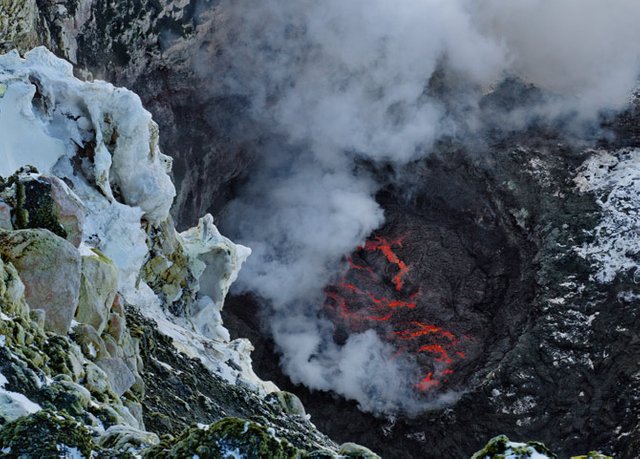
(Image from: nationalgeographic.com)
The lake
The lake came to the surface 45 years ago, in 1972. The 65-foot (20-meter) deep lake is 525 feet (160 meters) in diameter and sits in a 330-foot (100 meters) crater, within the Main Crater of Erebus’ volcano (approximately 500-600 meter in diameter). It connects to the magma chamber through a "pipe" that allows lava circulation from the deeper parts to the surface.
Thanks to this incessant magma flow, the burning lava (1832 °F – 1000 °C) does not get to freeze entirely in the surface of the lake. Hot magma climbs up, to meet the cooler surface, then cools down, becomes heavier and gets back into the magma chamber in an unending vicious cycle of lava flow. This pipe-through circulation is of critical importance for a lava lake’s existence and it’s really difficult to happen persistently, so we don’t get to see lava lakes very often.
No matter how cold it is in Antarctica, descending the crater to get heated up by the lake’s surface doesn’t sound like a good idea. The lake has been hurling deadly lava bombs with a diameter of a few centimeters to almost 2 meters, giving scientists a really hard time studying it. But if it weren’t for those lava-blob-defying scientists that have climbed down the dangerous slopes of the Erebus volcano to set up monitoring systems, we wouldn’t be able to know so much today. Those brave people have set monitoring equipment to watch volcanic activity 24-7. Thanks to advances in technology, the "aggressive" lava lake is under scrutiny with the hope of unveiling the volcano’s deepest secrets.
( Eruption in Erebus' lava lake captured by a thermal camera - Image from: www.livescience.com)
So far, they have noticed an unusual pattern in the volcanic gas release. The gases seem to follow a roughly 10-minute cycle. This cycle determines the amount and the composition of the produced gas. Scientists trying to find a reason for this strange behavior have ended up with this theory:
There are two main sources of gas, one comes from the fusion in the lake (the outer part of the magmatic body) where lava flows from within the conduit and releases rich in carbon dioxide gases (CO2). The other comes from the rising flows of deeper-level magma ascending the conduit (that happens approximately every 10 minutes) and releases a new set of gases rich in water vapor (H2O) and sulfur dioxide (SO2). As the gases come out of the conduit, lava levels rise and fall (for 6-10 feet/2-3 meters) following the gas flow. Then, pieces of lava cool down near the edges of the lake's surface, crack and flow outwards the hot lake.
Apart from this cycle, there is an extra feature on this lake, explosive degassing! And it’s as spectacular as it sounds. Basically, it’s like the volcano’s burping! It’s not so common, but when it happens the gases hurl up lava blobs all around the crater’s inner slopes. Those gases are not similar to the ones in the 10-minute cycle and scientists believe they come from deeper parts of the magma chamber.
Those two behaviors seem to be unrelated with each other. Think of it as if the first one is the breathing cycle, the gas flow supporting the volcano’s vital functions; and the second one is a burp, a large amount of uncontrollable gas that bursts out unexpectedly.
Mount Erebus is an amazing example of nature’s creativity. Try to picture it in your head: A big mountain with a lake full of boiling hot, red lava. Its slopes embroidered with smoke-spitting chimneys and underneath all that there is a system of multiple ice caves inhabited by carbon-dioxide-eating microbes! If that isn’t astounding, then what is?
Here is a great video of the SciShow youtube-series:
List of lava lakes around the world:
(All images from: thecampingcanuck.com)
1) Mount Erebus, on Ross Island (Antarctica)
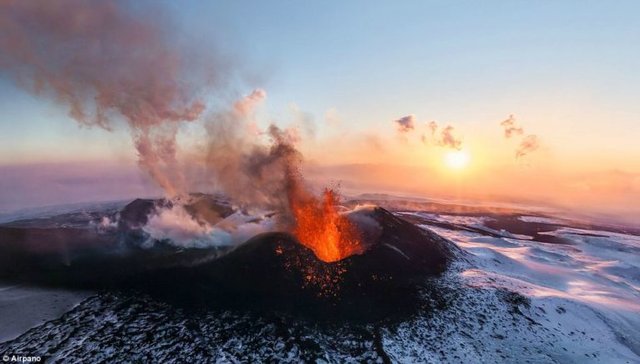
2) Ambryum, on Vanuatu Island (the Pacific Ocean)
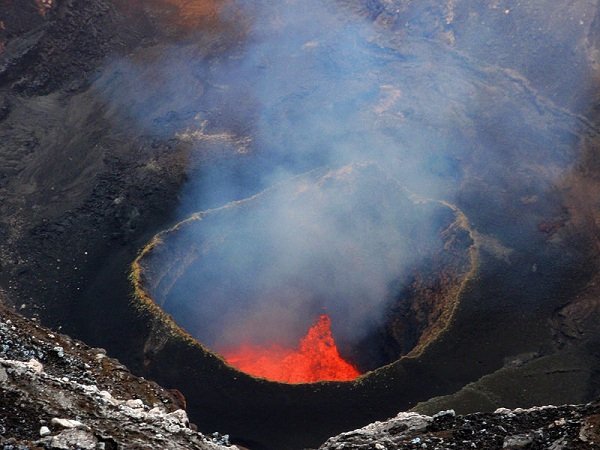
3) Kilauea, in Hawaii (the Pacific Ocean)
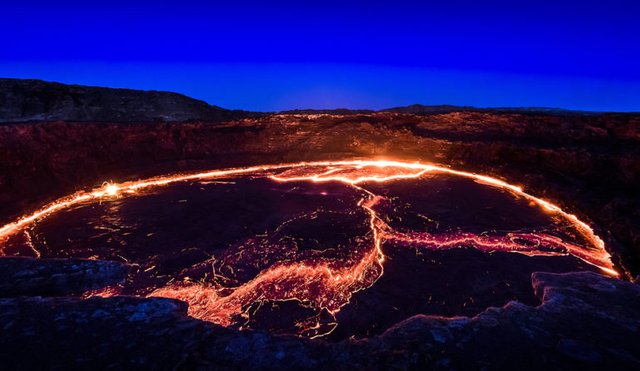
4) Ertha Ale, in Ethiopia (Africa)
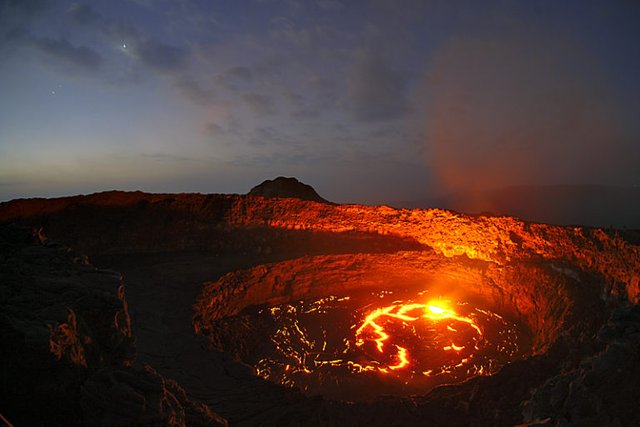
5) Mount Niyragongo, in the Democratic Republic of Congo (Africa)
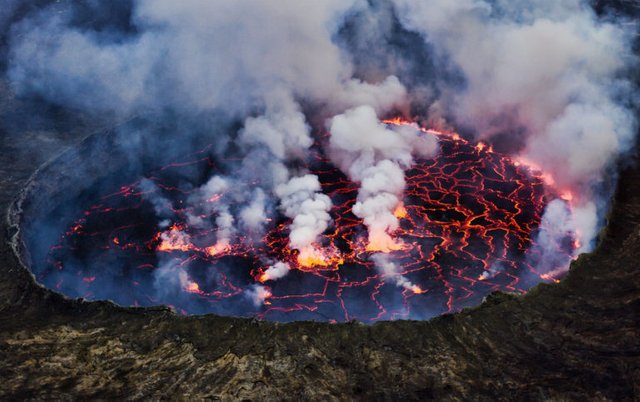
6) Masaya, in Nicaragua (Central America)
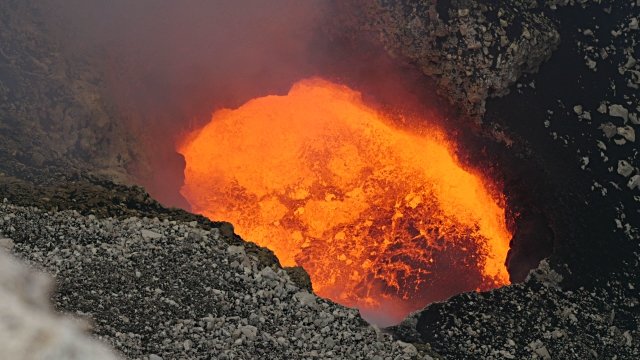
References
worldlandforms.com
polartrec.com
volcanolive.com
atlasobscura.com
en.wikipedia.org
livescience.com
thecampingcanuck.com

Thank you for reading my post! I hope it got you intrigued enough to follow me, @ruth-girl, for more fascinating phenomena!
If nature's weirdness is your thing, you can check the previous articles of this series:
1 - Volcanic Lightning
2 - Bioluminescence
3 - Flammable Methane Ice
4 - Door To Hell
5 - Blue Lava
6 - Everlasting Lightning Storm
7 - The Mummifying Lake
8 - Ice Fumaroles
9 - Blood Falls
Interested in science? Please, don't forget to check the @steemstem project, a community-driven project meant to promote well-written, high-quality, STEM-related content (STEM as for Science, Technology, Engineering and Mathematics). Join them in steemit.chat for more information.
And for those engaging with education, @steemiteducation is here to join all steemian educators in their common cause of making our job easier, more effective and more fun!
Until my next post,
Steem on, people, and keep smiling!

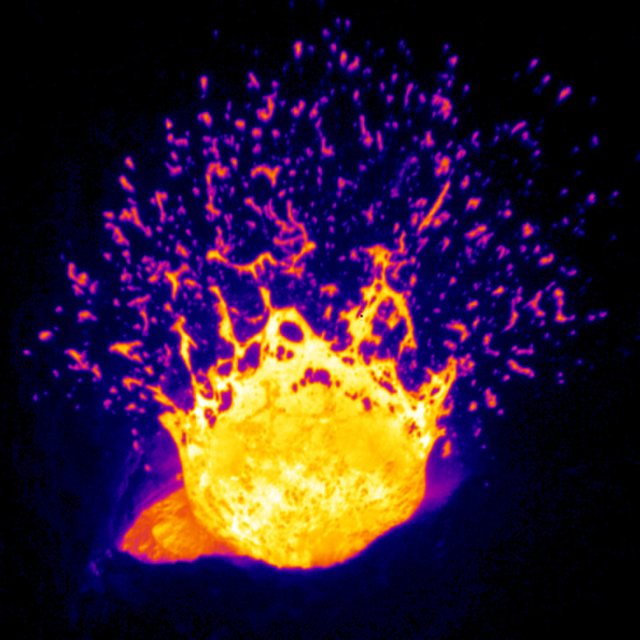
I would swim in that!
You're not Targaryen, honey! :P
No but I am a manly man
Upvoted and Resteemed by xx-votesplus, the dropAhead curation team!
Do you want more earnings?
By doing things above you will give us more STEEM POWER (SP) to give you more earnings.
Keep up the good work!
Most recent post: Moving #25_votes_plus to Discord
Resteemed and 100% upvoted. Thank you for using my service!
Read here how the new bot from Berlin works.
@resteem.bot
This post recieved a vote from @minnowpond. For more information click https://steemit.com/steemit/@minnowpond/boost-your-rewards-with-minnowpond
This post has received a 1.04 % upvote from @drotto thanks to: @banjo.
What an amazing place. Thanks for sharing!!@ruth-girl
I also write about my travels check it out :)
Followed and upvoted
upvote and follow me @zalb together we can succeed and share interesting stories!
I'm happy to hear that you liked it!!
I'll pay a visit to your blog ASAP!
This post recieved a vote from @minnowpond. For more information click https://steemit.com/steemit/@minnowpond/boost-your-rewards-with-minnowpond
Γεια χαρά ! Διατριβή θα κάνεις με 2-3 παρόμοιες αναρτήσεις ακόμη.. Πολύ ωραίο(προκαλούν δέος δε λέω ,αλλά είμαστε να ζοριζόμαστε τώρα; αστειεύομαι) . Καλή συνέχεια !
Χαχα! Ναι, θα με ζητάνε από τα Λονδίνα και τα Παρίσια για να τους μεταλαμπαδεύω τις αστείρευτες γνώσεις μου :P
Ευχαριστώ πολύ για τα ενθαρρυντικά σου λόγια!! :)
Thanks for the list of dangerous craters!
Now I know where not to fly my drone :p
Cheers!
Hahahaha! Can't wait to see those videos!! :D
Congratulations! This post has been upvoted from the communal account, @minnowsupport, by ruth-girl from the Minnow Support Project. It's a witness project run by aggroed, ausbitbank, teamsteem, theprophet0, someguy123, neoxian, followbtcnews/crimsonclad, and netuoso. The goal is to help Steemit grow by supporting Minnows and creating a social network. Please find us in the Peace, Abundance, and Liberty Network (PALnet) Discord Channel. It's a completely public and open space to all members of the Steemit community who voluntarily choose to be there.